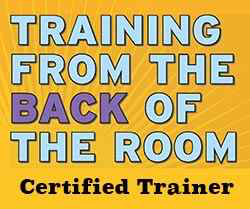Making the Time for Spaced Practice
 Sometimes all it takes is a gentle reminder – and some small chunks of time, spaced over a few days/weeks – to change a teaching, training, or learning habit (or, for that matter, to change ANY habit!).
Sometimes all it takes is a gentle reminder – and some small chunks of time, spaced over a few days/weeks – to change a teaching, training, or learning habit (or, for that matter, to change ANY habit!).
The post below is the “gentle reminder” I’m talking about – from one of my previous posts from over a year ago. It’s about “intermittent reinforcement,” which is a brain scientist’s term for “spaced practice.”
Spaced practice is really the only way human beings move information and/or skills into long-term memory. Instead of the traditional “cramming” method of learning – spending one large chunk of time repeating facts or skills over and over again – spaced practice means revisiting facts or skills in shorter segments of time spaced over a few days, weeks, or months.
Read on for my previous post about spaced practice and how to use this concept in your personal life, as well as when you are instructing others. And, if you haven’t already picked up your own free set of “Pocket Cards” (which are little gems of spaced practice examples), be sure to click on the red button at the bottom of this post.
“Spaced practice” is a gift you can give yourself and your learners for 2017. Forget about making huge changes to your own personal life in one gigantic sprint-to-the-finish. And forget about making sweeping changes to your instructional programs in one massive burst of effort.
 Instead, “get tiny.” Focus on the small steps, the tiny segments of time. Say you want to learn how to play the piano in 2017. Instead of setting aside thirty minutes to practice each day (a feat which can be quite challenging when your daily schedule is already crammed), set aside just ten minutes three times during the day: before you leave for work, when you get home, and just before bed. Why? Because brain research demonstrates that this kind of spaced practice helps build skills more effectively than massed practice in one sitting.
Instead, “get tiny.” Focus on the small steps, the tiny segments of time. Say you want to learn how to play the piano in 2017. Instead of setting aside thirty minutes to practice each day (a feat which can be quite challenging when your daily schedule is already crammed), set aside just ten minutes three times during the day: before you leave for work, when you get home, and just before bed. Why? Because brain research demonstrates that this kind of spaced practice helps build skills more effectively than massed practice in one sitting.
The same goes for exercise. While a 30-minute walk can get your heart-rate up and will do you a world of good, three 10-minute walks seem to give pretty much the same benefits, health-wise. Plus, they have an added benefit: a release of endorphins or “pleasure chemicals” in your brain that stay with you throughout the day because you spaced the practice time.
The benefits of spaced practice also apply to learning and memory. Spaced practice over the course of one day of instruction is better than one long practice activity at the end of the day. Spaced practice can be bits of review time: a minute here, three minutes there.
Here are a few examples of spaced practice activities that you can sprinkle into a class or training program:
1. Learners create a one-sentence verbal or written summary of the content you’ve covered so far.
2. You ask a question for all learners to answer, either verbally in pairs or in writing.
3. Learners take turns calling out facts they now know from the lecture segment you’ve just finished.
4. Learners participate in a one-minute paired discussion about what they’ve learned so far.
5. Learners create flashcards as you lecture so that they can revisit the content later.
6. Learners pair up and take turns demonstrating one step in a skills-procedure.
Your training participants will learn more – and remember more – when you use spaced practice during your classes and training programs.
 Meanwhile, back to 2017 and you. Want to change a bad habit or begin a beneficial one? Think intermittent reinforcement. Spaced practice. Get tiny. Use bits of time to make small changes in your diet, exercise, health, or well-being. Whatever you want to change for 2017, do it in small, incremental steps. And be sure to reward yourself when you do! Happy New Year to you and yours!
Meanwhile, back to 2017 and you. Want to change a bad habit or begin a beneficial one? Think intermittent reinforcement. Spaced practice. Get tiny. Use bits of time to make small changes in your diet, exercise, health, or well-being. Whatever you want to change for 2017, do it in small, incremental steps. And be sure to reward yourself when you do! Happy New Year to you and yours!
For a collection of 10 spaced practice activities that have to do with creating positive health habits for 2017, click on the red button below. Feel free to share these little Pocket Cards with family members, work colleagues, and friends.
ONLY TRAINER CERTIFICATION COURSE FOR 2017!
 I hope you can join me, and an enthusiastic group of global trainers, for the 2-day “Training from the BACK of the Room” class and the 1-day Trainer Certification Course in San Diego, April 6th – 8th 2017. This will be the only time the Trainer Certification Course will be offered for 2017. Both classes are sponsored by The Brain Trust Consulting Group and will be held back-to-back, right before the San Diego 2017 Scrum Alliance Gathering.
I hope you can join me, and an enthusiastic group of global trainers, for the 2-day “Training from the BACK of the Room” class and the 1-day Trainer Certification Course in San Diego, April 6th – 8th 2017. This will be the only time the Trainer Certification Course will be offered for 2017. Both classes are sponsored by The Brain Trust Consulting Group and will be held back-to-back, right before the San Diego 2017 Scrum Alliance Gathering.
Click HERE for more information about “Training from the BACK of the Room” and “The Trainer Certification Course.” See you in San Diego!
Thanks for your informative comment, Theresa. I too, need to use more global digital tools to teach online. Your comment was definitely food for thought! 🙂 Sharon
Schools are now using technology to teach online, and there are Global Curriculum Projects. As educators we need to collaborate and teach students globally using, for example, Skype, Kahoot, and Google Hangouts. Teachers need to use a new approach to curriculum planning, and I need to get into this habit.